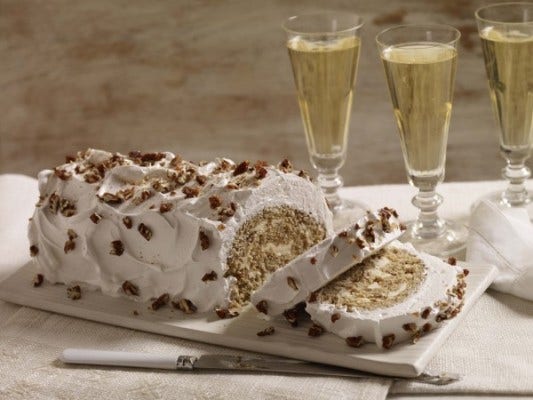Fox & Food: Holiday Baking with Dorie Greenspan

courtesy: Baking Chez Moi
photo credit Alan Richardson
Baking legend Dorie Greenspan chats with Fox News Radio’s Lilian Huang Woo about her latest book Baking Chez Moi, memorable treats for your holiday table and her own memories of working with Julia Child.
Take a LISTEN:
Gingerbread Bûche de Noël
Makes 12 servings
Yule logs are such a part of the French Christmas tradition that a month or two before the holiday, pâtissiers start previewing their new creations, rather like fashion designers with their collections. And weeks before, every newspaper and food magazine runs a photo-filled story on what the top pastry houses will offer. It’s a dream book and shopping list rolled into one.
Since we spend the holidays in Paris, I get a chance to sample a few cakes each season. My bûche strategy for dinners at home is simple: One time I’ll buy one, the next time I’ll bake one. With so many fanciful cakes in the shops, making my own is unnecessary, but I’ll never give it up, mostly because it’s so much fun to make a rolled up cake and even more fun to serve it. It’s a project, yes, but a completely satisfying and delicious one.
This bûche has the flavor of gingerbread—it’s spiced with cinnamon, ginger and black pepper, sweetened with brown sugar and rolled up around a cream cheese and praline filling that’s lick-the-spoon wonderful. (The filling, packed in a jar, is a great gift on its own, to be spread over toast or on cookies.) The pecan praline is quick and easy to make and it adds terrific flavor and crunch. I chop some of it very finely—you can crush it, if you prefer—and stir it into the filling. I chop the remainder a little more coarsely and sprinkle it over the billowing, snow-white marshmallow frosting.
Everything but the frosting can be made ahead, so you can get a jump on things. You need to spread the frosting as soon as it’s made, but the cake needs to be refrigerated after it’s frosted and it can stay in the fridge for up to 2 days, so there are no last-minute to-dos with this beauty. And just because it’s called a bûche de Noël doesn’t mean you can’t stud it with candles and call it a birthday cake.
A word on tools: You’ll need a candy thermometer for the frosting and a stand mixer.
For the praline
1 cup (120 grams) pecan halves or pieces
1/3 cup (67 grams) sugar
¼ cup (60 ml) water
For the cake
¾ cup (102 grams) all-purpose flour
¼ cup (32 grams) cornstarch, sifted
¾ teaspoon ground cinnamon
¾ teaspoon ground ginger
¼ teaspoon fine sea salt
¼ teaspoon freshly ground black pepper
6 large eggs
¾ cup (150 grams) packed light brown sugar
½ stick (4 tablespoons; 2 ounces; 57 grams) unsalted butter, melted and cooled
Confectioners’ sugar, for dusting and rolling
For the filling
8 ounces (227 grams) cream cheese, at room temperature
1 stick (8 tablespoons;
4 ounces; 113 grams) unsalted butter, at room temperature
Pinch of fine sea salt
½ teaspoon ground cinnamon
2 teaspoons pure vanilla extract
For the frosting
1/2 cup (120 ml) egg whites (about 4 large)
1 cup (200 grams) sugar
¾ teaspoon cream of tartar
1 cup (240 ml) water
1 tablespoon pure vanilla extract
To make the praline: Center a rack in the oven and preheat the oven to 350 degrees F.
Line a baking sheet with parchment or a silicone baking mat and spread the pecans out on the baking sheet. Bake the nuts for 3 minutes (you want to heat, not toast, them), stir them around and then put them in a warm spot while you cook the sugar.
Put the sugar in a small saucepan and pour over the water. Swirl to moisten the sugar, then put the pan over medium-high heat. Cook the sugar, washing down the sides of the pan if needed with a pastry brush dipped in cold water, until the sugar turns a medium amber color. (Stay close; sugar changes color quickly.) Turn off the heat, add the nuts to the saucepan (set the lined baking sheet aside) and stir a few times with a heatproof spatula or a wooden spoon, just to coat the nuts with syrup. Pour the caramelized nuts out onto the baking sheet and use the spatula, spoon or an offset metal spatula to spread them out. If they won’t spread out, no matter—you’re going to chop them anyway. Let cool completely. (The praline can be made up to a day ahead, packed in a container and kept in a cool, dry place—moisture is praline’s nemesis.) Finely chop 1/2 cup of the praline; coarsely chop the remainder.
To make the cake: Center a rack in the oven and preheat the oven to 350 degrees F. Line a 12-×-17-inch rimmed baking sheet with a piece of parchment paper. Butter the paper, dust with flour and tap out the excess. Whisk the flour, cornstarch, cinnamon, ginger, salt and pepper together in a small bowl.
Have a wide skillet about one-third full of simmering water on the stove. Working in the bowl of a stand mixer, or in a heatproof bowl in which you can use a hand mixer, whisk together the eggs and brown sugar. Set the bowl in the pan of simmering water (pour off some water if you’re concerned that it will slosh over the sides) and whisk nonstop until the mixture is very warm to the touch, about 2 minutes. Remove from the heat.
If you’re using a stand mixer, attach the bowl to the stand and fit it with the whisk attachment, or use a hand mixer. Working on high speed, beat the sugared eggs until they are thick and pale, have more than doubled in volume and have reached room temperature, 7 to 10 minutes. Switch to a flexible spatula and fold in the flour mixture in 2 additions. Be as delicate as you can and don’t be overly thorough now—you’re going to continue to fold when the butter goes in. Put the melted butter in a small bowl, scoop a big spoonful of the batter over it and stir. Turn this mixture out onto the batter in the bowl and fold it in: Cut deep into the center of the bowl and search the bottom for unincorporated flour—find it and fold it. Scrape the batter out onto the prepared baking sheet and spread it evenly with an offset spatula.
Bake for 13 to 15 minutes, or until the cake is golden brown, lightly springy to the touch and starting to pull away from the sides of the baking sheet. Transfer the baking sheet to a cooling rack, but keep it on the rack for no more than 5 minutes; you want to roll the cake while it’s hot.
Lay a cotton or linen kitchen towel (not terrycloth or microfiber) on the counter and dust it generously with confectioners’ sugar. Run a table knife around the sides of the cake and invert the cake onto the towel. Carefully peel away the parchment. Lightly dust the cake with confectioners’ sugar and replace the parchment, putting the clean side against the cake (or use a new piece). Starting at a short end, roll the cake into a log; this is a preroll, so it doesn’t have to be tight or perfect. If the cake cracks, keep rolling— the filling and frosting will patch everything. Return the rolled-up cake (still in its towel) to the rack and let it cool, seam side down, to room temperature.
Meanwhile, make the filling: Put the softened cream cheese, butter and salt in the bowl of a stand mixer fitted with the paddle attachment, or work in a large bowl with a hand mixer. With the mixer on medium speed, beat until the cream cheese and butter are homogeneous and smooth. Beat in the cinnamon and vanilla. If you’re going to use the filling now, stir in the 1/2 cup finely chopped praline; if not, wait until you’re ready to fill the Yule log. Transfer to a bowl, cover and refrigerate. (You can make the filling—without the praline—up to 2 days ahead and keep it well covered in the refrigerator.)
To fill the log: If the filling has been chilled, give it a good whisking to return it to a spreadable consistency; add the praline if you haven’t already done so.
Unroll the log and carefully remove the parchment; leave the cake on the kitchen towel. Beginning with a short end, gently roll up the cake, peeling away the towel as you go. Unroll the cake onto the towel or a clean piece of parchment.
Spread the filling across the surface of the cake, leaving a scant 1-inch border uncovered on the long sides. Again starting from a short side, roll up the cake, leaving the towel or parchment behind and trying to get as tight a roll as you can. If you’d like, tighten the log using the paper-and-ruler technique. Place the cake on a parchment-lined cutting board, cover it and chill it for 30 minutes.
Meanwhile, make the frosting: Put the egg whites in the clean, dry bowl of a stand mixer fitted with the whisk attachment or in a large bowl that you can use with a hand mixer.
Stir the sugar, cream of tartar and water together in a small saucepan. Bring to a boil over medium-high heat, then cover and boil for about 3 minutes. Uncover, attach a candy thermometer to the pan and cook until the thermometer reads 242 degrees F (this can take almost 10 minutes).
When the sugar reaches 235 degrees F, begin beating the whites on medium speed. If you get to the point where the whites look like they’re about to form stiff peaks and the syrup isn’t at 242 degrees F yet, lower the mixer speed and keep mixing until the sugar is ready.
At 242 degrees F, with the mixer on medium speed, stand back and carefully and steadily pour the hot syrup into the bowl. Try to get the syrup between the side of the bowl and the whisk. Perfection is impossible, so ignore any spatters; don’t try to stir them into the frosting. Add the vanilla and keep beating until the frosting cools to room temperature, about 5 minutes. You’ll have a shiny, marshmallow frosting, which you should spread now.
To frost and finish the log: Remove the cake from the refrigerator. You can frost it on the cutting board and then transfer it to a serving platter or put it on the platter now. To keep the platter clean during frosting, tuck strips of parchment under the log, putting just a sliver of the parchment under the cake and leaving the lion’s share to protect your platter.
If the ends of the log look ragged, trim them. Using an offset spatula, table knife or the back of a spoon, swirl the frosting all over the cake in a thick layer. Refrigerate for at least 1 hour to set the frosting and firm up the filling.
Sprinkle the cake with the remaining coarsely chopped praline before serving.
Serving: Bringing the cake to the table is its own dramatic event, but there’s no reason not to add to the drama by making it the sole event. Instead of waiting to serve the log après dinner, have an afternoon holiday party and serve just the cake and Champagne. It’s a very chic way to say Merry Christmas!
Storing: Covered lightly and kept away from foods with strong odors, the cake will keep in the refrigerator for up to 2 days. Serve it chilled.

courtesy: Baking Chez Moi
photo credit Alan Richardson
Edouard’s Chocolate Chip Cookies Makes about 50 cookies
When Edouard Bobin, the co-owner of one of the sweetest small bistros in Paris, Le Pantruche, said he would give me the recipe for his favorite hazelnut cookie, I knew the minute I read the one-word title, Cookies, that chocolate chips would be involved. See the word “cookies” (or the words “les cookies”) in France, as you do nowadays in glossy magazines, modern bakeshops and trendy cafés, and it’s a pretty risk-free bet that the sweet will turn out to be a chipper. If there are nuts, they may be hazelnuts, pecans, walnuts or macadamias; there may even be a few M&M’s-type candies pressed into the dough; and the chocolate can be any kind, the basic cookie is always a play on the American chocolate chip.
And so it was with Edouard’s cookies. In fact, as I looked at the recipe, I thought it was the standard back-of-the-bag recipe. It had the American mix of baking powder and baking soda (the French mostly use packets with the two leavening agents already combined), the same amount of chocolate chips as you get in a U.S. bag and the same number of eggs as in the classic American recipe. I’d hoped for something new, and I didn’t think this was going to be it.
But I hadn’t noticed a couple of important differences: Edouard called for almost half again as much flour (by weight) as our classic recipe, and the nuts were ground not chopped, acting like even more flour. The cookies were chubby and chewy and just a little soft at the center—altogether great. If this is what the French think of as American cookies, we Americans can be proud.
3½ cups (476 grams) all-purpose flour
1¼ teaspoons fine sea salt
¾ teaspoon baking soda
½ teaspoon baking powder
2 sticks (8 ounces; 226 grams) unsalted butter, at room temperature
1 cup (200 grams) sugar
1 cup (200 grams) packed light brown sugar
1½ teaspoons pure vanilla extract
2 large eggs, at room temperature
12 ounces (340 grams) semisweet or bittersweet chocolate, coarsely chopped (or 2 cups chocolate chips)
1½ cups (150 grams) hazelnut or almond flour
Whisk the flour, salt, baking soda and baking powder together in a medium bowl.
Working in the bowl of a mixer fitted with the paddle attachment, or in a large bowl with a hand mixer, beat the butter on medium speed for about 1 minute, until smooth. Add both sugars and beat for another 2 minutes or so, until well blended. Beat in the vanilla. Add the eggs one at a time, beating for 1 minute after each egg goes in. Reduce the mixer speed to low and add the dry ingredients in 4 or 5 additions, mixing only until each addition is just incorporated. (Because you’re going to add more ingredients after the flour, it’s good not to be too thorough.) Still on low speed, mix in the chocolate and nut flour.
Divide the dough in half, wrap each piece airtight in plastic film and refrigerate for at least 2 hours. (The dough can be refrigerated for up to 3 days. Or, if it’s more convenient for you, you can scoop the dough now and freeze it in balls. You won’t need to defrost the cookies, but you will need to bake them a little longer.)
When you’re ready to bake: Center a rack in the oven and preheat the oven to 350 degrees F. Line two baking sheets with parchment paper or silicone baking mats.
Edouard says to scoop the dough into mounds the size of golf balls. A medium cookie scoop with a capacity of 1½ tablespoons is just right here, but you can also spoon the dough out using a rounded tablespoon of dough for each cookie. Place the dough on the lined sheets, about 2 inches apart.
Bake the cookies one sheet at a time for 8 minutes and then, using a metal spatula, gently press each mound down just a little; rotate the baking sheet. Bake for another 7 minutes or so, until the cookies are pale brown. They’ll still be slightly soft in the center, but that’s fine—they’ll firm as they cool. Pull the sheet from the oven and allow the cookies to rest for 1 minute, then, using a wide metal spatula, carefully transfer them to racks to cool to room temperature.
Repeat with the remainder of the dough, always using a cool baking sheet.
Serving: The cookies are good warm or at room temperature; good with coffee, good with tea and terrific with milk (a beverage I’ve never seen a grown French person sip); and even good with Armagnac.
Storing: The best way to maintain the cookies’ chewiness is to store them in a zipper-lock plastic bag; they’ll stay fresh for about 3 days. You can keep them longer, of course; just know that they’ll get a little firmer as time passes. Or pack them in an airtight container and freeze them for up to 2 months.
Recipe excerpted from Baking Chez Moi, copyright 2014 by Dorie Greenspan. Reproduced by permission of Houghton Mifflin Harcourt. All rights reserved.
Follow Lilian Woo on Twitter: @LilianNY
Click HERE to listen to more FOX & Food podcasts

courtesy: Baking Chez Moi
photo credit Alan Richardson







